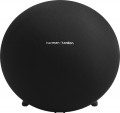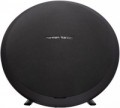System power
The total sound power provided by the audio system at maximum volume, in other words, the total power of all the speakers provided by the device (including the subwoofer).
The higher the power, the louder the system will sound and the larger the area it can cover. On the other hand,
high power significantly affects the price, dimensions, weight and power consumption of the device. In addition, when evaluating and comparing according to this indicator, it is worth considering some nuances. Firstly, some manufacturers go to the trick and give in the characteristics not the average, but the peak sound power; such numbers can be quite impressive, but they have very little to do with real loudness. So if it seems to you that the claimed power is too high, it's ok to clarify what exactly is meant in this case. Secondly, when comparing, it is worth considering the presence of a subwoofer — it plays an auxiliary role, but it can account for more than half of the total system power. Because of this, for equal total power, a device with a subwoofer may be quieter than a model without a subwoofer: for example, a 2.0 40W system will have 20W per main channel, while a 2.1 40W model may have 20W per subwoofer, and only 10 watts for the main speakers.
Frequency range
The total frequency range reproduced by the acoustics of an audio system. Measured from the lower threshold of the lowest frequency speaker to the upper threshold of the highest frequency: for example, in a 2.1 system with main speakers at 100 – 22000 Hz and a subwoofer at 20 – 150 Hz, the total value will be 20 – 22000 Hz.
In general, the wider the frequency range, the fuller the reproduced sound will be, the less low and high frequencies will be lost due to insufficient acoustic capabilities. On the other hand, do not forget that the actual sound quality also depends on a number of other parameters — primarily the frequency response. In addition, human audible frequencies range from 16 Hz to 22 kHz; deviations from these values are very small, and the upper limit also decreases with age. Therefore, from a practical point of view, it does not make sense to provide too large a frequency range; and impressive performances like 10 – 50000 Hz, found in top-class models, are usually more of a kind of "side effect" of high-quality speakers (and at the same time — a marketing ploy) than a really significant moment.
More features
—
Omnidirectional sound. As the name suggests, audio systems with this feature emit sound evenly in all directions, covering a 360° space. Thus, the device can be installed in the center of the room and evenly “fill” it with sound, which will be clearly perceived at any point. On the other hand, an omnidirectional system usually sounds in 1.0 format (mono); the design may include various tricks to ensure surround sound, but such systems still fall short of full-fledged stereo in most cases.
—
Voice assistant. Support of the audio system of the voice assistant. The most popular assistants nowadays are:
However, other solutions can also be used. In any case, it is worth noting that we are not talking about the function of the audio system itself, but about compatibility with smartphones, tablets and other gadgets that have their own voice assistants. Thus, to use the voice assistant, you will have to connect the audio system to an external device. On the other hand, the capabilities of such assistants are usually more extensive than those of built-in
voice control systems (see below); advanced functions are often supported, such as natural speech recognition with complex queries (“Play the latest album of the band ... that I listened to”), voicing the weather forecast, sports results, etc. Of course, the specific set of supported commands and languages may vary - depending on the voice assistant and its version.
— Voice control. A function that is practically mandatory for smart speakers (see “Purpose”) and is almost never found in other types of audio systems. As the name suggests, this control allows you to control the device using voice commands. It differs from the voice assistant (see the corresponding section) in that in this case we are talking about the simplest commands related to the main functionality of the audio system - for example, “Stop”, “Continue”, “Next track”, etc. It is worth keeping in mind that voice control almost certainly supports English, but the ability to recognize other languages should be clarified separately.
— Mobile application. The ability to control the audio system from a smartphone, tablet or other gadget with a special application installed on it. As a rule, the connection is via Wi-Fi (see "Interfaces"). The convenience of this function is not only that the system can be controlled remotely - the application is often more convenient and provides more options than the controls on the radio itself.
— Multiroom support. The device supports Multiroom technology. This technology allows you to create a single wireless network in your home from several speakers placed in different rooms, and simultaneously play music in all of these rooms. The specific features of such networks may be different in different models, they should be clarified separately. So, some devices use a Bluetooth connection, others - via Wi-Fi (directly or via a local network). In some cases, the control speaker broadcasts sound to all the others, and the same music plays throughout the house, in others, the speakers are "equal", and different tracks can be played simultaneously in different rooms. Some audio systems require an external sound source (smartphone, tablet, etc.), others are capable of playing the role of a player themselves, including for streaming Internet services.
—
Karaoke.... A popular entertainment that allows users to sing their favorite songs to a backing track (musical accompaniment with the original vocals cut out) — so that the vocals superimposed on the backing track are reproduced through the acoustics of the audio system. This function requires at least one microphone input.
— Karaoke Mix. An extended version of karaoke (see above), providing various additional options — for example, assessment of performance skills in points, singing competitions, etc. As a rule, it allows you to connect two microphones.
— Internet radio. The ability to listen to Internet radio stations on the audio system. In general, such broadcasting is similar to conventional broadcasting, but it is carried out not via radio, but via the World Wide Web, which provides some additional opportunities. Thus, Internet broadcasting has no restrictions on range and range, allows you to listen to programs from any country and in any language; and the list of broadcasters is extremely extensive, among them there are both traditional radio stations duplicating their broadcasts on the Internet, and specific, purely network projects. The presence of this function assumes support for at least one network interface - Wi-Fi or LAN (see "Interfaces").
— Recording to a USB drive. The ability to operate the audio system in recording mode to an external USB device, such as a flash drive. This allows you to record your favorite radio programs from a regular tuner or Internet station (see above), copy music from optical discs, etc.; specific USB recording capabilities depend on the audio system model.
— Clock. A regular clock is a device for displaying time, most often in the form of numbers on a display. Sometimes it is precisely such a clock that turns out to be the most convenient. In addition, this function is necessary for some other features — primarily an alarm clock (see below).
— Alarm clock. A classic alarm clock that gives a signal at a set time. It can be useful not only for waking up, but also in other cases when it is necessary to warn the user about the onset of a certain time. The peculiarity of this function in audio systems is that the signal can be the switching on of a certain radio station or musical composition.Inputs
—
RCA. The RCA interface uses coaxial cables with characteristic tulip plugs and corresponding connectors. It can be used to transmit different types of data, but in this case it is meant to connect an audio signal from a preamplifier in analog format, one audio channel per connector. RCA is widely used in modern audio equipment, but its resistance to interference is very modest.
—
Mini-Jack(3.5 mm). Standard connector for most modern portable audio equipment. In audio systems, it is mainly used to connect such equipment — primarily pocket media players. It uses analog signal transmission, but its resistance to interference, like that of RCA, is low, and the quality may be even lower due to the fact that both stereo sound channels are transmitted via one cable.
—
Coaxial S/P-DIF. An electrical variation of the S/P-DIF standard that uses a coaxial cable with a tulip connector to transmit the signal. This interface should not be confused with the analog RCA described above — despite the identity of the connectors, these standards are fundamentally different: “coaxial” operates in digital format and allows for the transmission of even multi-channel sound over a single cable. Compared to optical S/P-DIF, this interface is less resistant to interference, but more reliable, since the electrical cables are not as delicate.
— Optical. One of the varie
...ties of the S/P-DIF standard — along with the coaxial one described above. In this case, the signal is transmitted via a TOSLINK fiber-optic cable. The main advantage of this interface is its complete insensitivity to electrical interference, while its capabilities are sufficient even for working with multi-channel sound. Among the disadvantages, it is worth noting the high price of connecting cables, as well as the need for careful handling of them.
— For microphone. Input for connecting a microphone to an audio system; can use different types of connectors (3.5 mm mini-Jack, 6.35 mm Jack, etc.). This function is mandatory for models with karaoke (see "Additional"), but can also be used for other purposes.
— Instrumental. Connectors used to connect musical instruments (acoustic or bass guitars, keyboards, etc.). Most often, they are made in the form of 6.35 mm Jack sockets. The audio signal from the pickups has its own specifics, so the instrument input is usually characterized by a higher input signal level and special impedance matching to ensure optimal sound quality.
